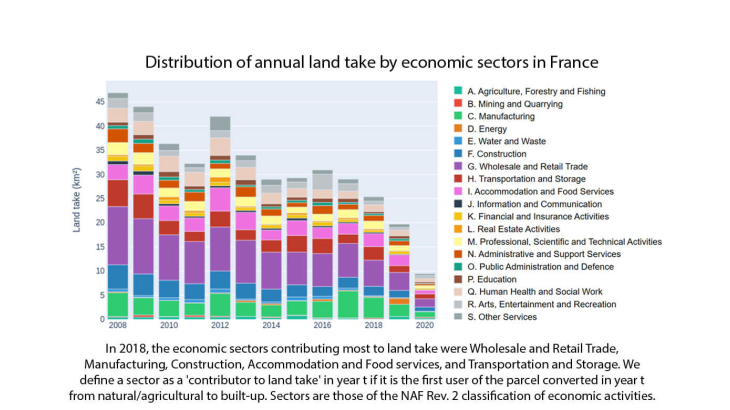How do economic sectors use built-up land in their production process? What sectors contributed most to land take, which is the conversion of agricultural, forest and natural land into built-up land, resulting in biodiversity loss and a degradation of soil functions? How vulnerable are economic sectors to a decrease in the availability of land and a land prices hike? In 2021, the French Parliament passed a law aiming for 'No net land take' (NNLT) by 2050, while the rate of land take should be halved by 2031. This paper investigates the potential impacts of this policy on economic sectors.
We construct annual accounts of the use of built-up land (a stock) and the contribution to land take (a flow) by each economic sector in France between 2008 and 2021. We do so by spatially matching the surface of built-up land at the parcel level (from Fichiers fonciers, CEREMA) with the establishment of French firms (from Sirène, INSEE), based on their location. We then aggregate the surface of built-up land used by establishments at the NAF sector level. The new databases we obtain first enable us to draw stylised facts regarding the use of built-up land and the land take by sectors. Regarding land take, we find that the Wholesale and Retail Trade sector has been the main contributor throughout the period, even though its absolute and relative impact has declined. Sectors like Manufacturing, whose contribution to land take increased over the period, Construction, Transportation and storage, and Accommodation and food services were also significant contributors. The latter sector has contributed to a significant part of the land take occurring in natural areas. Moreover, this work helps understand how economic sectors use the total stock of built-up land. Some sectors require substantial built-up areas per establishment on average, particularly Mining and Quarrying, Energy and Waste and Water, or subsectors like steel and cement manufacturing.
Based on this analysis, we explore the relative vulnerability of economic sectors to the NNTL policy in case the latter contributed to increasing land prices (which, however, is not a necessary outcome of the law). We develop a multi-criteria analysis disentangling various vulnerability components using our database and complementary data sources, such as firms' balance sheets. The sectors that emerge as most vulnerable include Agriculture and Accommodation and food services, while some sectors producing public goods (Waste and water treatment) could face financial difficulties to cope. Finally, although some sectors seemed more likely to be exposed to increasing land prices because of their important use of built-up land (such as Wholesale and Retail Trade, Transportation and storage, or even Manufacturing), they appear somewhat able to adapt relatively to other sectors, thanks to financial or technical means.
Our work contributes to several strands of the literature. First, our accounts of built-up land use and land take complement the existing environmental accounting tables, enabling the assessment of the built-up land footprint of economic activities. By exploring the type and surface of built-up land used by different economic sectors, it is also inscribed in the literature working towards integrating land as a production factor. It contributes to the emerging field of macroeconomics focusing on the transition to protect nature, in particular via land-use policies. Finally, our paper is a step in analysing economic and financial transition risks beyond those induced by the low-carbon transition.
Investigating the economic vulnerabilities to a policy may help envisage its broad set of consequences. In particular, it aims to anticipate forthcoming changes (e.g., incentivise economic sectors to change the way they use land, including through technical and organisational change), revealing possible trade-offs, and triggering reflections on the possible tools to support a reduction in the demand for built-up land (e.g., through mixed use of existing buildings). As was already emphasised by classical economists, land is finite, and dealing with its scarcity should be of concern for economics today.
